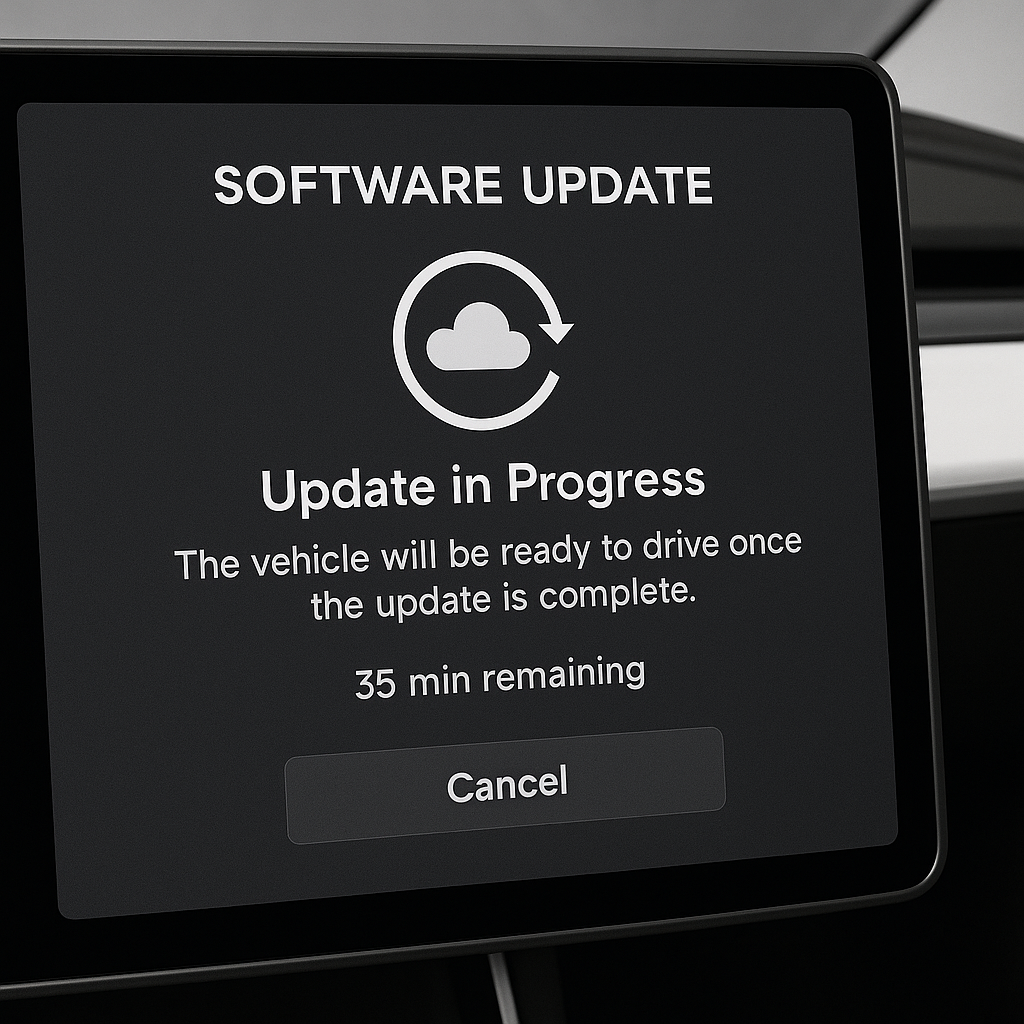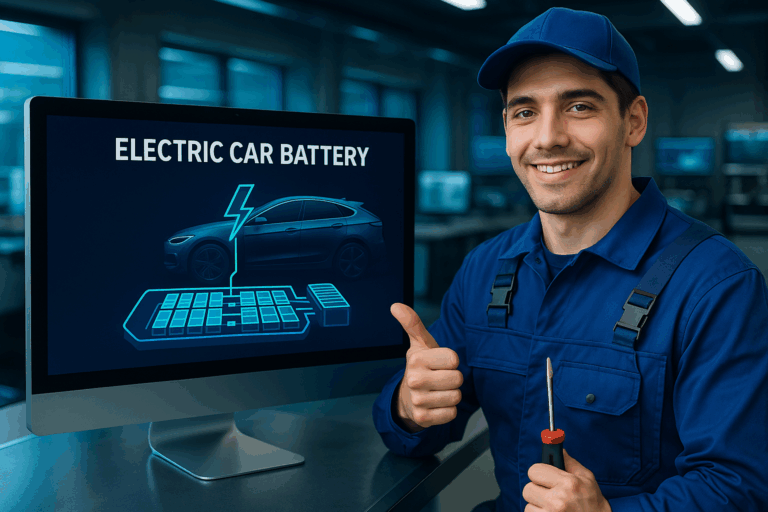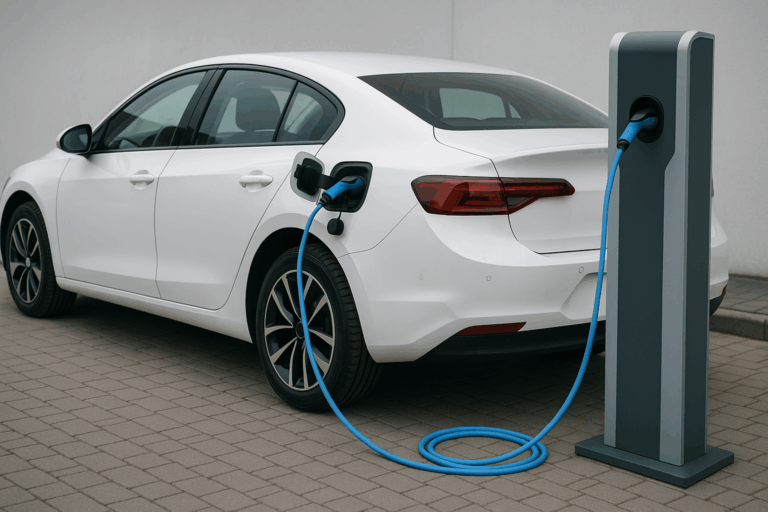The Ultimate Electric Vehicle Maintenance Guide: Tips, Costs & Schedule
Electric vehicles (EVs) are simpler than gas cars, but they still need regular care to stay safe and efficient. For example, AAA reports that EV maintenance is very affordable – around 8.12¢ per mile on average – because EVs have fewer moving parts and no engine oil to change. That said, EVs still need attention on items like the battery, brakes, tires, filters, charging gear, and seasonal prep. This guide (with examples from Tesla, Hyundai, Volkswagen, and Kia EVs) will walk new EV owners through everything they should check, how often to do it, and typical U.S. costs.

EVs often avoid many traditional services: no oil changes, spark plugs or exhaust tune-ups. Instead, think of maintenance in terms of batteries and electronics. For example, Tesla recommends an annual service (about every 12,500 miles or 12 months) that includes inspecting the car and rotating the tires, and then at two years adding brake fluid and cabin filter replacement. Likewise, VW’s ID.4 calls for a “minor” service every 10,000 miles (tire rotation, 12V battery check) and a “major” service at 20,000 miles (coolant check, multi-point inspection, etc.), with cabin filter and brake fluid changes every two years. We’ll cover each of the key service areas below.
EV Battery Care and Lifespan

The high-voltage battery is the heart of an EV, so keeping it healthy is crucial. Fortunately, modern EV batteries are very durable. Most come with an 8–10 year or ~100,000 mile warranty (10 years/150,000 miles in some states). Real-world data shows EV batteries degrade only about 2–3% per year on average. That means after 10 years and 100,000 miles, a typical battery might still be ~80% of its original capacity. In fact, a two-year Stanford study of EV batteries suggests many packs could last well beyond 200,000 miles without needing full replacement. When replacements are needed (usually out of warranty), costs today are roughly $5,000–$16,000 depending on battery size – but such cases are still quite rare.
To maximize EV battery life and range:
- Charge wisely. Keep the state-of-charge between about 20% and 80% for daily use. Avoid routinely charging to 100% or letting the battery run all the way to empty, unless needed for a long trip. Most EVs let you set a charge limit in the software.
- Prefer slow charging when possible. Frequent DC fast (Level 3) charging can accelerate degradation. Use Level 2 (240V) charging for regular use and reserve fast-charging for occasional long drives.
- Manage temperature. Park your EV in a garage or shaded spot to avoid extreme heat or cold. If your model has thermal management, use preconditioning: warm up the battery before driving or charging in winter, and avoid very hot charging sessions in summer. In freezing weather, preheat the battery (if the car supports it) and use eco-mode to save power. In hot weather, park in the shade and charge during cooler parts of the day.
- Check battery coolant (if applicable). Many EVs (like Kia EV6, Hyundai Ioniq 5, etc.) use a liquid coolant loop for the battery. Kia’s schedule, for example, calls for checking the battery coolant level around every 15,000 miles and replacing the coolant at roughly 37,000 miles. Follow your owner’s manual on coolant service intervals.
- Software updates. Keep your car’s firmware up to date. Automakers often release over-the-air (OTA) updates that improve battery management and efficiency.
Overall, you can expect an EV battery to last well over a decade or 100,000+ miles under normal use. With careful charging habits and temperature management, many owners never have to replace the high-voltage pack. (In the rare case you do, parts alone run on the order of thousands of dollars.) The key is simply to avoid extreme states of charge and temperatures, which keeps your range steady and delays degradation.
EV Brake System Maintenance
EVs use regenerative braking to slow the car first, so the mechanical brakes actually work less hard. This means brake pads and rotors usually last much longer in an EV. It’s not uncommon for pads to stay in good shape for 80,000–100,000 miles or more. However, EV brakes do still need attention. Corrosion and moisture can affect any brake system over time, so regular inspections are important.
- Inspect pads and rotors. At each service interval (typically yearly or every ~10,000 miles), have a technician check brake pad thickness and rotor condition. Replace any pads that are worn below the manufacturer’s spec (often about 3–4 mm thickness). Watch for unusual noises or reduced braking, which would prompt earlier service.
- Brake fluid flush. Brake fluid absorbs moisture over time and loses its boiling point. Even though EVs rely on regen, the fluid still needs to be replaced periodically. Most EV makers call for a brake fluid change every 2–3 years (e.g. Tesla does it at 2 years). If your manual is silent, a good rule is to replace brake fluid about every 18–24 months. This keeps the system safe under hard braking.
- Brake pad replacement. Because pads wear slowly, you may only need pad changes every many years. When they do wear out, labor and parts can cost a few hundred dollars for all four wheels. (For example, RepairPal estimates a full pad job around $300–$400.) Plan on checking pads annually so you can replace them before they get too thin.
- Rotor care. If rotors develop grooves or rust, have them resurfaced or replaced at the same time as pads. Clean and inspect rotors when doing the fluid flush or brake service.
Electric cars still need brake checks. Regenerative braking saves wear, but have pads, rotors, and brake fluid inspected per schedule (often yearly or every ~10k mi). Above, a rusty brake disc — EVs can corrode brakes if unused for a while.
Key takeaway: EVs greatly reduce brake wear, but you still must maintain the brake system. Inspect pads and discs regularly (e.g. once a year) and flush the brake fluid roughly every 2 years. This ensures stopping power when you need it, especially in wet or winter conditions.
EV Tire Care, Rotation and Replacement
EVs put out massive torque and tend to be heavier (due to the battery), so tires wear faster than on a small gas car. Many shops report EV tires last only 20,000–40,000 miles on average. That’s because the extra weight and instant power increase friction and stress on the rubber. The good news is EVs use low-rolling-resistance tires that are engineered for longevity, but you still need to watch them closely.
- Regular tire rotation. To even out tread wear, rotate your tires frequently – typically every 6,000–10,000 miles (or about once a year). A common pattern (on non-directional tires) is to swap front-to-rear diagonally. Rotations cost around $50–$70 if done at a shop, though many dealers or tire retailers offer free rotation with purchase. Keeping rotations on schedule maximizes tire life and maintains handling.
- Check pressures monthly. EV tires should be kept properly inflated for safety and to maximize range. Temperature swings (like hot summer vs. cold winter) can change tire pressure, so check at least monthly and adjust to the manufacturer’s recommended psi. Underinflation causes uneven wear and wastes range.
- Use EV-rated tires. When it’s time to replace worn tires, choose ones rated for EV weight (often with an extra “Reinforced” or “EV” label). These have stronger sidewalls and special rubber to handle the load. They cost a bit more — typically $150–$300 per tire for a midsize EV — but they last longer and maintain efficiency.
- Monitor tread depth. Most EV makers say to replace tires before they fall below about 3 mm of tread (U.S. law uses 2/32″ or 1.6 mm as a bare minimum). If you notice uneven wear or the traction warning light, get an alignment or new tires. Alignment checks once a year help prevent premature wear.
- Drive smoothly. Hard acceleration, cornering, and sudden braking all scrub off more rubber. By driving gently (especially in an EV’s instant-torque environment), you can significantly extend tire life.
EV tires wear faster due to extra weight and torque. Rotate tires every 6,000–10,000 miles and keep pressures correct to make them last.
Typical tire rotation service costs about $50–$70, and a full set of new EV tires for a midsize car can run $600–$1,200 for four (depending on brand and size). Watching tires closely and rotating often is key to avoiding early replacements.
EV Software Updates and Diagnostics

One advantage of modern EVs is over-the-air (OTA) updates. Manufacturers like Tesla, Volkswagen, Hyundai and others routinely release software updates that improve performance, add features, or fix bugs. Generally, you should:
- Install all updates. If your EV is capable of OTA updates, enable them and let the car download/install when parked. These can improve battery management, safety, range, navigation, and more. If your EV isn’t OTA-enabled, check with the dealer for software updates during service. Staying up to date ensures your EV runs optimally.
- Run diagnostics on warning lights. If a dashboard alert or warning light appears (such as battery, motor, or “service vehicle soon” alerts), don’t ignore it. Have the car scanned with the appropriate EV diagnostic tool. Routine diagnostics (often included in service) can detect issues early.
- Use the car’s health apps. Many EVs have companion apps or menus that report battery health or diagnostics. Periodically review these (and share them with your service center if you have any concerns). For example, some tools can track battery capacity over time to spot unusual drops.
In short, think of EV software like your smartphone – keep it updated! Regular updates and any needed system checks are part of maintenance. Most over-the-air updates are free, and apart from that, electronic diagnostics usually happen during scheduled service visits.
EV Cabin Air Filter Replacement
Cabin air filters clean the air entering your car’s HVAC system. Like any car, EVs need this filter changed to keep the vents blowing fresh, clean air. A dirty filter reduces airflow and efficiency of the climate system.
- Replace every 15,000–30,000 miles. Manufacturers often recommend cabin filter changes roughly every 1–2 years. For example, Kia’s EV6 and EV9 schedule calls for a new cabin filter at about 24,000 km (15,000 miles) or 24 months. VW’s ID.4 recommends a pollen/cabin filter change every two years. Check your owner’s manual, but a good rule is every 15k–30k miles.
- Cost. Having a dealer or shop replace the filter typically costs around $80–$100 total (parts plus labor). Many filters themselves are only $20–$50, so DIY saves on labor if you’re handy. Since this is simple and the part is inexpensive, you can budget about $50–$100 per replacement.
- Signs it’s due. If you smell musty air, or the climate system seems weaker, it’s time to change it. A quick visual check (some filters are behind gloveboxes or under dash) will show if the filter is clogged with leaves or dust.
Tip: Use your EV’s HVAC system occasionally to circulate air even in winter (many have “recirculate” options). This can dry out moisture in the filter. Just remember to switch to fresh-air mode or replace the filter before the pollen-heavy spring!
EV Charging Port and Cable Care
Your charging equipment needs gentle care too. The charging port on the car and the cables (charging cords) should be kept clean and damage-free.

- Inspect regularly. Whenever you wash your car or at service, look at the charging port and cable plug. Clear any debris, leaves or dirt from the port. A cotton swab with isopropyl alcohol can clean electrical contacts if they look grimy. Simply closing the port cover when not in use will keep most dust out. One source advises “Clean and inspect charging ports periodically” to ensure good contact.
- Check cables for damage. Examine your charging cables (especially portable Level 2 cables) for frays, kinks or exposed wires each month or so. Replace any cable that shows wear. High-quality replacement EV charging cords cost on the order of $100–$300, so it’s worth swapping a worn one early.
- Protect the cable. Avoid tightly coiling the charging cable when storing it (use the loops recommended in the manual), and don’t set anything heavy on it. Keep cables off the road or sidewalk to avoid being run over.
There’s no fixed schedule for cables – just common sense. If you notice a loose connection or the EV blinking during charge, inspect the plug and port immediately. Otherwise, a quick monthly look-over is plenty.
Seasonal EV Maintenance (Summer and Winter Checks)
Because extreme temperatures affect EVs more than gas cars, it’s smart to give your EV some seasonal TLC.
- Winter Prep: In cold weather, battery chemistry slows and cabin heating uses more energy. To maximize winter range: precondition your battery and cabin while plugged in (many EVs let you schedule this). Park in a garage if possible. Use “eco” or “low” heating modes and heated seats/wheels instead of blasting heat. Check that coolant (if your EV has liquid cooling) is at the right concentration (antifreeze level) before cold snaps. Check tire tread and consider winter tires – grip is crucial on ice. Also, battery range will drop in the cold, so plan for shorter trips or charging breaks. As one guide notes, “Precondition the battery in cold weather” and park in a warm place to help.
- Summer Prep: In heat, keep batteries cool. Park in shade or a garage and avoid charging at noon or in hot sunlight. If your EV has a liquid cooling system, inspect the radiator and coolant hoses for leaks or blockages and top off the coolant if needed. Make sure your A/C is working well (EV A/C uses some battery power, so an efficient system helps range). You can also consider pre-cooling the car before summer drives using grid power. Keep tire pressures as heat will increase them – check early summer pressure to adjust for the warm air. In essence, treat summer much like normal car prep: clean out debris, check all fluids (washer, brake, radiator), and ensure ventilation is clear.
By planning for seasons (e.g. scheduling service or inspections just before winter and summer), you can avoid surprises. For instance, AAA emphasizes that “maintaining your EV in different climates” and preconditioning can preserve range. In short, use shade and ventilation in heat, and use pre-warming and indoor parking in cold.
EV Maintenance Schedule and Costs
Below is a basic maintenance schedule for EVs, summarizing major tasks, recommended intervals, and rough costs in USD. (Actual intervals can vary by model; always follow your owner’s manual.)
| Service Task | Recommended Interval | Typical Cost (USD) |
| Tire rotation | ~6,000-10,000 miles (6-12 months) | $50-$70 per service |
| Tire replacement (set of 4) | ~20,000-40,000 miles | $600-$1,200 (for 4 tires) |
| Brake fluid flush | ~2 years (or 30-40k miles) | $100-$150 |
| Brake pad replacement | As needed (when worn) | $300-$400 for four pads |
| Cabin air filter replacement | ~15,000-30,000 miles (1-2 yrs) | $80-$100 |
| Battery coolant replacement | ~3-5 years (or 30-60k miles) | ~$100-$150 |
| 12V accessory battery | ~every 6 years or as needed | $50-$100 |
| Software update (OTA) | As released (often free) | $0 (over-the-air) |
| Charging cable inspection | Monthly visual check | ~$0 (cable cost if replaced) |
| High-voltage battery (out of warranty) | Possibly 8-15+ years; 100k+ miles | $5,000 – $15,000 |
Notes on costs: The above figures are ballpark ranges for U.S. service by independent shops or dealers. For example, a typical tire rotation costs around $50–$70, and a brake fluid flush about $100–$150. Cabin air filter change (labor + part) is often around $80–$100. If you replace items yourself (tires or filters), you’ll pay only parts. Software updates and diagnostics during service are usually included at no extra charge.
The most expensive maintenance item could be the battery pack, but again this is rarely needed. Modern EV batteries often outlast the car itself, and when outside warranty they can be costly (roughly $10,000 or more for a large pack). However, many owners never pay that out of pocket thanks to warranties.
Tips for Reducing Long-Term Costs and Boosting EV Performance
Keeping an EV running its best is not just about following the schedule, but also about smart daily habits. Here are some friendly tips:
- Drive smoothly. Gentle acceleration and braking reduces wear on tires and brakes and also extends battery range. Sporty driving in an EV can wear parts faster.
- Use eco modes. Many EVs have an “Eco” or “Energy Saving” driving mode. Using these can limit power output and climate load, extending each charge’s range without harming the car.
- Proper tire inflation. Underinflated tires can increase rolling resistance (wasting energy) and wear out unevenly. The boost in range from correct pressure is small but free. Check tire pressure at least monthly.
- Plan charging costs. If you install a Level-2 home charger, it’s an up-front cost ($500–$2,000 ) but it makes daily charging more efficient. Also charge during off-peak electricity rates if your utility offers time-of-use pricing.
- Stay on top of recalls. Manufacturers sometimes issue software or hardware recalls (e.g. for battery management). Sign up for recall alerts (using your VIN) so you can get fixes promptly at no charge.
- Use warranties and service plans. If you lease or lease-like finance an EV, service plans (offered by brands) might be worthwhile. Also, battery and drive unit are usually covered under separate long-term warranties (8+ years). An extended warranty on electronics/charger can pay off if you plan to keep the car long.
- Keep it clean (body & underbody). Washing the car, including the underbody, helps prevent corrosion on brake rotors and suspension parts – especially in winter where road salt is used. A little soap and water now can save paint and metal later.
By staying proactive (checking lights, fluids, and filters regularly), you usually catch small issues early. Regular alignment checks and rotations make the biggest difference in how long tires last. In short, treat your EV like a precision gadget: keep it updated, insulated from extremes, and lightly tuned. Over time this minimizes repairs and keeps the car at peak efficiency.
Being an EV owner means less maintenance, but not zero. Using the above schedule and tips, you can enjoy the low running costs of electric driving while avoiding surprises. In summary:
- Batteries: Work to keep them between 20–80% charged, avoid extremes, and schedule coolant and software updates as recommended.
- Brakes: Check pads yearly, flush fluid every 2–3 years – they’ll likely outlast you by a lot, but don’t skip them.
- Tires: Rotate often (6–10k mi), keep pressure correct, and plan for replacements in the 20–40k mi range (using EV-rated tires).
- Filters and fluids: Replace cabin filters (~1–2 yrs), inspect washer and coolant fluids seasonally, and change any brake or battery coolant per your manual.
- Electronics: Embrace OTA updates, use diagnostic checks when needed, and inspect charging hardware routinely.





